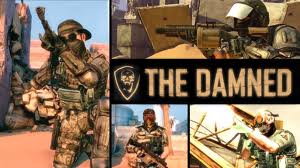
Film poster of the movie
The Damned is a 2012 historical drama detailing the doomed efforts of the OFN 33rd infantry battalion to maintain order in Iberia following the Eurasian deluge in 1975, which would fail horrifically due to dwindling US support, worsening public relations between them and the Iberians, ecological collapse from the nuclear fallout, and in the films climax the collapse of the Gibraltar dam, ultimately destroying all civil order in Southern Europe. Disgraced, the OFN pulled a hasty retreat from Europe with as much soldiers and refugees as could fit on the aircraft. Mark Sinclair's heart wrenching performance as Lt. Col. John Konrad, a man who's forced into committing worse and worse acts to maintain order until he realizes he's no better than the men who destroyed Europe, would gain the film critical acclaim and nearly won him an Oscar. It would however pick up Oscars in other areas, and plans for a sequel titled the Exiles, which will follow an inadvertently abandoned Delta Force team and their struggle to return home, set to release in 2021.

